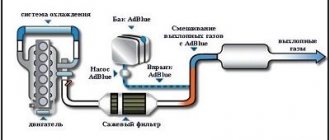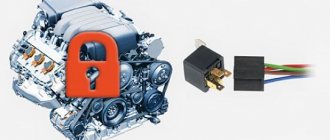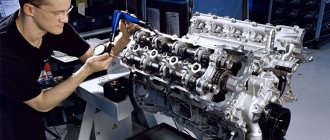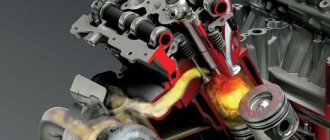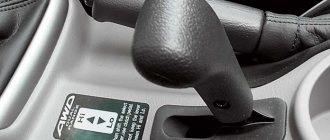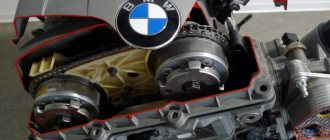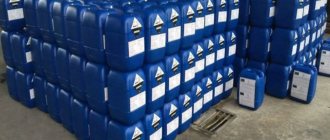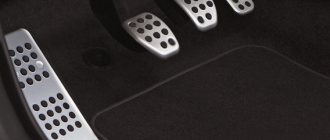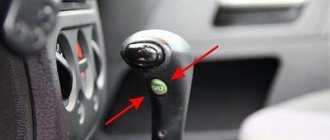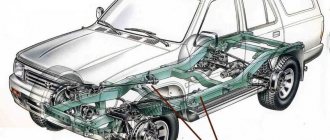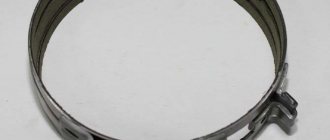Engine malfunction
Engine troubleshooting is an inspection and measurement of the characteristics of parts that need to be repaired or replaced. It allows you to identify specific spare parts that have been destroyed, as well as the reasons why this destruction occurred. It’s one thing when all engine parts wear out evenly (in the case of natural wear). Another is when “criminal traces” are clearly present. In this case, you need to accurately determine the cause of what happened. Since the usual replacement of worn parts with new ones, without identifying the cause of the malfunction, can lead to the need to repair the engine again.
What does engine troubleshooting include?
The first troubleshooting of parts is carried out directly during the disassembly process - each part removed from the engine must be carefully checked “by eye”. Completely destroyed parts, as well as parts that cannot be restored, should be set aside separately so that you can later create a list of what needs to be purchased as a replacement. Externally safe parts, without visible damage, will be inspected at the second stage of defect detection - when checking their dimensions and characteristics for compliance with the nominal ones. It is recommended to maintain a defect sheet, which includes the date of the defect and a list of parts that were found to be operational and were not replaced. This measure will help to more accurately compile a list of replacement parts during the next troubleshooting.
When troubleshooting an engine, special attention is paid to the engine cylinder block. This is the basis of the entire power plant. In addition, this part is numbered, which in case of failure will lead to problems not only with repair work, but also with documents.
One of the most common defects is the presence of longitudinal scratches on the piston. Due to such scratches, the piston rings will not cope with their task, and the engine will begin to consume oil unnecessarily. The reason is a lean mixture in the cylinders. The problem is solved by checking the fuel mixture supply channels. There may be problems with the intake manifold supply pipes, carburetor or injector. A lean mixture can also be caused by a leak in the exhaust gas recirculation system.
If cracks are detected on the cylinder bore, as well as internal cracks in the oil channel, the block must be rejected. The decision on possible repairs when cracks appear in the cylinder is made by the grinder. In this case, you can line the cylinder block. However, this is determined separately in each specific case.
If the cylinder block is found fit for use as a result of engine troubleshooting, then it is subject to washing, opening the oil cavities, washing and steaming them, and restoring factory standards by regrinding to the repair size.
Scratches on the surface of the cylinders
Causes:
- Failure of piston rings.
- Engine overheating.
- Defects in piston bridges between grooves.
- Operating the engine with a damaged air filter for a long time.
The correct installation of the ignition system is checked and its adjustment is carried out. Troubleshooting experts advise using fuel with the octane rating recommended by the manufacturer. If necessary, the piston ring sizes are sharpened or liners are sharpened.
Troubleshooting is: concept, methods of carrying out
Any concept has its own definition. Troubleshooting is a procedure for expert assessment and identification of the cause that caused the breakdown of an engine or any other mechanism. The procedure itself consists of identifying and eliminating all types of defects, with an assessment of their cost, drawn up in a special act. Most often, troubleshooting is carried out for cars that have been in an accident.
Features of the troubleshooting procedure. What is this?
Defect detection is an evaluative diagnostic procedure that reveals hidden damage. It is carried out by a specialist through inspection and use of technical and electronic means. Troubleshooting identifies any internal damage, the need to replace functional parts, and checks the operation of mechanical systems. Based on the verification, a list of services, the use of parts is created and the full cost of work and spare parts is calculated. The cost of troubleshooting depends on the need to disassemble the vehicle; for visual inspection and disassembly, it ranges from 300 to 1,500 rubles. Information from the defect report can be used for:
- assignment of insurance payments;
- confirmation of repair costs;
- documentary support for the use of warranty or service.
The troubleshooting procedure takes no more than one day, is carried out in the presence of the customer, with the issuance of a report on the day of application, and the receipt of oral and written recommendations.
Defect sheet
The procedure for registering identified malfunctions (defects) in the operation of a unit or mechanism is documented in a document indicating the calculation of the scope of work (estimate). The statement is compiled by a specialist who indicates in it:
- all types of necessary work (installed and completed);
- number of actions (volume);
- the materials used and their real cost (domestic and imported raw materials are listed, exclusive ones must be indicated);
The specified work in the statement must be completed correctly:
- Detail the list.
- Specify the type of work (what kind of repair was carried out).
- Call a traffic police officer, who issues a certificate and indicates visible damage to the car.
- Contact the insurance company with a corresponding application.
- Contact an automotive expert. The specialist will conduct an accurate assessment of the damage using modern electronic systems and document them in the inspection report, indicating the calculation of the necessary costs and the method of eliminating external and hidden internal defects: welding, straightening, replacement of spare parts, painting.
- The car owner must request from the car service technician an Inspection Certificate for the vehicle (vehicle) indicating the required elimination of defects, the price list, and order the defect detection process itself.
A correctly drawn up estimate before a meeting with the customer saves time for both parties to the contract to specify services to eliminate the defect. In this case, the calculation of work and the cost of materials and spare parts used is an important component.
Defective car
An accident that has occurred, as an assessment of the damage and damage caused, requires the following sequence of actions when applying for insurance:
It is very important to have an official document on hand regarding the injuries sustained during the accident. In case of disputes with the insurance company, this document may be required in court.
Conclusion
There is no need to delay the troubleshooting, since the sooner the car owner contacts the car service center, the faster the insurance company will pay for hidden damage.
Cylinder surface development
Causes:
- Ignition system malfunction.
- Failure of the power supply system.
Diagnostics, repair and adjustment of the power supply and ignition systems are carried out. Severe wear on the surface of the blocks is repaired with a sleeve or boring.
The absence of a hone grid on the surface of the cylinders is one of the indirect signs of wear. During troubleshooting, specialists check the taper, bore and ellipse of the cylinders as follows: each cylinder is checked with an indicator bore gauge at three points in two mutually perpendicular planes. The stop zone of the upper compression ring usually shows the heaviest wear. The methods of boring and honing followed by lining are used when working out in cylinders more than 0.1 mm.
What is a car defect detection: act, form, sample, sorting of parts
Cars, like other technical means and equipment, in many cases require expertise and technical inspection. To reflect the actual results of these actions, a standard document recognized by everyone is needed, which is the defect detection act.
What is a car defect report?
This document is drawn up upon inspection of the car and officially records the defects, breakdowns or defects discovered during the inspection. It is compiled when: The purpose of its appearance is to find out the answer to the following questions:
The video below will tell you what a vehicle inspection report is:
What regulations governs
Legislation no longer requires adherence to unified forms when drawing up primary documents, which undoubtedly include the defect detection act. But in order to avoid unforeseen consequences when troubleshooting a car, you must adhere to the standards prescribed in documents such as:
Who compiles it and where it is used
The act is drawn up by an expert commission, which should include representatives of all interested parties:
- Car owner.
- Technical experts.
- Repair companies or vehicle dealers.
In this case, the presence of persons with appropriate qualifications for the given situation is mandatory. This act is used by the company that owns the car to:
- Justification of costs for machine repairs.
- Confirmation of the legality of writing off parts, components or the car as a whole.
For private owners, this form of act will help them understand the scope of repair work and make the right decision about their need.
How a document is compiled
When drawing up an act, you must adhere to the following rules:
- Compose even with minor defects.
- Enter all names (company, owner's name, car name, names and part numbers) without abbreviations.
- Documents confirming the purchase or installation of parts must be attached to the act.
- The defect inspection report is drawn up immediately before repair (write-off) or immediately after it.
- The act is drawn up by hand, corrections are not allowed.
- The act is signed by the head of the organization responsible for its correct execution, and approved by the owner of the car or his authorized representative.
Form
A typical form of defect detection used when inspecting a vehicle should include:
- The name of the document with its number.
- The name of the organization and, if necessary, its structural unit performing this work.
- The date of the inspection and the number of the order for the company on its implementation.
- Full name of the car and its technical data.
- List of members of the commission by name, indicating their positions or relationship to the commission.
After the introductory part of the document there follows a summary of the defect detection in the form of a plate, including:
- Serial number.
- Name of the part or assembly.
- Quantity.
- The type of malfunction or defect.
- Description of measures to eliminate the detected breakdown, including types of repair work.
Then follow the conclusions of the commission, formalized as a decision with the signatures of all its members. https://www.youtube.com/watch?v=DymZV5xK4U8 The defect report is approved by the head of the company and, if necessary, agreed with the owner of the car.
Provisions and examples
But in some cases, when a car is defective, the final act includes special provisions, which will be outlined below using specific examples. The form can be downloaded here. Sample car defect report
Engine malfunction
This is a labor-intensive process requiring:
- Preliminary visual inspection.
- Then dismantling with measurements and assessment of the performance of all parts.
- Drawing up a defect report for the engine.
This act must include:
- Document number, date and time of inspection.
- Details of the company conducting the examination and the customer.
- Inspection location.
- Information about the model, year of manufacture and vehicle number.
- Engine number and type.
- The amount of mileage.
- Description of operational defects recorded prior to inspection.
- List of identified faulty or broken parts.
- Expert conclusion on each of them (repair or replacement).
- Signatures of all inspection participants.
The video below will tell you about troubleshooting and maintenance:
Defective parts
A defective car part may have:
- External damage , which can be detected visually at the time of purchase.
- Internal malfunction , determined only during installation or during operation.
In both cases, a complaint is filed, accompanied by a defect report, which looks like this:
- The name of the act with the number and indication of the place of inspection.
- Names of defective parts.
- Description of the defect.
- Indication at the time of detection of the malfunction (in the warehouse, before installation, after installation).
- Conclusion about the need for replacement.
- List of parts required for replacement with quantities.
- Commission signatures.
The act is approved by the head of the organization from which this commission was selected.
After an accident
Troubleshooting after an accident is carried out for:
- Find out the cost of repairs.
- Determination of the amount of compensation.
It is carried out:
- Independent expert companies and includes, in addition to the act, a complete set of documents confirming it. But this service is paid.
- When the car comes in for repair, it is free of charge, but in this case an agreement with all interested parties is required.
The document itself must contain the following information:
- Full details of the organization conducting the examination.
- Name and number of the report, date, time and place of inspection.
- Place and date of the accident.
- Certificate number from the traffic police.
- Name, number, make and color of the car.
- Numbers of main units.
- Certificate of registration and full details of the owner.
- This is followed by a list of damaged parts indicating the location, nature, type and extent of the fault.
- There should also be recommendations on the possibility of restoration or replacement.
- Confirmation of defect detection results by commission members and interested parties, including car owners and road accident participants.
Useful information on the topic
When drawing up a defect report for machine repair, the following sequence of actions is used:
- External inspection of the car.
- Visual inspection of components and parts using special measuring equipment.
- Dismantling of units.
- Identification of hidden defects.
- Measurements of parts.
- Paperwork.
This video will show with a specific example what car troubleshooting is:
Requirements for drawing up
- The number in order is entered in the first column, and the defect found in the second. For example, clutch disc wear.
- The next column indicates the nature of the work. In our case, this could be: replacing the clutch disc or basket.
- The following indicates the quantity and what it is measured in. At the bottom of the statement there must be an inscription stating that the owner has become familiar with the defective statement and his signature.
If a commission, represented by an accountant, workshop manager and other persons, takes part in drawing up the defect report, then this fact is necessarily reflected in the document. At the end of the procedure, their signatures are placed on the act.
Engine overhaul. What it is?
Disassembly, washing, defect detection, assembly - these are the main engine repair work that can be expressed financially. Let's talk about them.
Disassembly
The engine removed from the car (without technical fluids) enters the engine shop and is installed on a rotary stand. The engine is disassembled into components and parts.
Washing
Next, all engine elements are thoroughly washed with MS-8 solution in a special installation. The oil channels are washed with a special gun. The purpose and objectives of this important process is to remove dirt, carbon deposits, and tar deposits from parts and internal cavities of the engine for high-quality defect detection.
Defect
Perhaps the most critical stage for the further operation of the engine, which affects the service life of the unit. The task is to identify parts that have damage, fatigue cracks, scuffs, and non-compliance with working drawings. An external inspection reveals visible damage, cracks, scuffs, chipping, fistulas, and burnouts. Using a special tool, we identify defects in parts associated with extreme wear, bending, misalignments, loss of hardness, and hidden defects.
Cylinder block
An external inspection reveals cracks, fistulas, and nicks. Using bore gauges and test rulers, we check the alignment and dimensions of the main bearings of the camshaft bushings and the parting surface with the cylinder head. The crankshaft is the heart of the engine. An external inspection reveals cracks and nicks. We check the bend of the shaft using a special prism; a special device is used to determine the hardness of the journals, which is very important when the shaft jams due to oil starvation (blue journals). Using micrometers and internal gauges, we check the dimensions of the main and connecting rod journals, fits under the gears, and axial displacement rings.
connecting rod
An external inspection reveals cracks, breaks, scuffs, burns from turning the liners. Using internal gauges and devices, we check for bending and twisting, and wear on the surface of the upper and lower connecting rod heads. Sleeve piston group. An external inspection reveals cracks, abrasions, and burnouts. Internal gauges, feeler gauges - elecsity, piston-liner clearance, pin hole, grooves for piston rings.
Camshaft
An external inspection reveals cracks and burrs. On a special prism - the beating of the necks for deflection. We check the wear of the cams with micrometers.
Block head
An external inspection reveals cracks, fistulas, and burnouts. Using a special ruler, we check the mating surface of the head with the block. Valve-bushing interface, condition of seats, valve springs, spark plug holes, injectors. An example of defect detection of main engine elements is given, which identifies parts that are serviceable, require repair, and are unusable. A defect sheet and cost estimate are drawn up and agreed upon with the customer. After the indicated work, we can talk about the final cost of the engine overhaul.
Engine assembly and running-in
After the engine is equipped with new and repaired spare parts according to the defect list, engine assembly begins. The assembled engine is installed on the stand, the systems are connected, coolant and oil are filled. For four hours, the unit undergoes a cold run-in in different modes in order to identify noises, knocks, control oil pressure, and grind in the main elements. The readings taken are recorded in the passport. https://www.youtube.com/watch?v=yxEGpo-_Kw0 “Cargo Service” magazine No. 10 `2011
What spare parts are needed
Consider the list of spare parts for major repairs of the power unit:
Piston group kit, it includes pistons, piston rings, piston pin. If the block is sleeved or such a need arises, then sleeves are purchased accordingly. When purchasing a piston group, there is no need to rush; you must first take the block to where you are going to sharpen it, and only after measuring the master will tell you what type of repair the piston needs to be purchased. It's a matter of desire; if you want, you can purchase pistons with recesses, especially useful if you are experimenting with split gears, etc. And the chain, despite its reliability, can break once every 20 years and then the meeting of the pistons with the valves is inevitable. Main and connecting rod bearings are purchased after the crankshaft has been ground. After grinding the crankshaft, the master will tell you which bearings you need to buy - 0.25, 0.50, 0.75, 1. This depends on the degree of wear of the crankshaft. It is better to take original earbuds. Oil pump. This matter is quite controversial, but I prefer to change it when conducting capital
Many people say that it can last for a very long time - I don’t take into account such stories, do it like that. Camshaft I also recommend replacing it, but if finances are really bad, then you can postpone replacing it, but this is very undesirable
Although if the camshaft is in good condition, you can leave it. The intermediate shaft (drive shaft of auxiliary units, pig) is the shaft that rotates the distributor and the oil pump and is driven by a motor chain. This shaft greatly affects the pressure in the lubrication system - if the bushings are heavily worn, the oil pressure drops significantly. When overhauling an engine, the bushings must be replaced, processed with reamers, and the shaft is also either ground or replaced with a new one. There is also an intermediate shaft on ball bearings; this, in addition to increasing the service life of the industrial shaft, also allows you to increase the pressure in the lubrication system. From all this, it is necessary to take away that at the time of sending the block for grooving, you need to purchase a new one or take with you an old washer so that you can replace the bushings and grind the shaft (if you leave the old one), at least this is the case with us. If the cylinder head is also being repaired, then it is necessary to purchase valves, valve seals, and springs (if the old ones do not hold the force). I also recommend replacing the entire motor chain tensioning system, as well as the motor chain itself, this includes: crankshaft, camshaft, shaft sprockets, motor chain, motor chain tensioner shoe, motor chain tensioner, motor chain damper. Beware of fakes, there have been cases when the motor chain tensioner shoe was made of non-oil resistant rubber and it collapsed quite quickly. I try to install a plastic damper, since even if it breaks, it may not harm the engine as much as a rubber-metal one. The crankshaft seals, rear and front, must be replaced. You also need to purchase a set of gaskets, you can buy all paper gaskets separately, and buy them separately for the pan, valve cover and under the cylinder head. Also check the bearing, which includes the gearbox input shaft, at the end of the crankshaft. If there is play in the bearing, it must be replaced. If the engine knocks or the connecting rod bearing turns, then the connecting rod must be replaced. Also, do not forget about all the consumables - oil, filter, coolant.
Engine troubleshooting: what is it and what is it for?
Troubleshooting is a procedure for expert assessment and determination of the cause of a breakdown of an engine or any other mechanism. It consists of identifying and eliminating defects, accompanied by an assessment of their cost, confirmed by the relevant act. Troubleshooting is most often carried out for cars that have been in an accident.
Features of the troubleshooting procedure
Defect detection is an assessment and diagnostic procedure that reveals hidden damage. It is carried out by a specialist through inspection using electronic and technical means. During troubleshooting, internal damage to the mechanism, the performance of individual systems are identified, and the need to replace functional spare parts is determined. Based on the results of the inspection, a list of services, parts used and calculation of the full cost of work and components are created. How much does it cost to troubleshoot an engine? The price varies from 300 to 1500 rubles, depending on the need to disassemble the vehicle. The information provided in the sample defect report can be used for:
- assignment of insurance payments;
- confirmation of costs incurred for repairs;
- maintenance support or warranty.
Troubleshooting is carried out within one day in the presence of the customer. On the day of application, a sample defect report is filled out and written and oral recommendations are issued.
Statement
Identified malfunctions in the operation of mechanisms or units are documented in a defect sheet, which indicates the amount of work and their calculation. The specialist draws up a statement and indicates in it:
- Types of work identified and performed.
- Scope of actions taken.
- List of materials used and their cost with the obligatory indication of exclusive ones.
The work indicated in the defective list must be correctly completed:
A correctly drawn up estimate makes it easier to draw up a contract for the provision of services and saves time for both parties. Important components of the document are the cost of the spare parts and materials used and the calculation of the work.
Defective car
In the event of an accident, the following actions are performed to assess damage and apply for insurance compensation:
Troubleshooting the power unit
Engine troubleshooting is carried out in several stages:
Defective cylinder block
The central part of any engine is the cylinder block. Its failure can lead to serious technical problems. Timely and competent troubleshooting of engine parts will help determine the causes of engine failure and the possibility of its further operation.
- Troubleshooting involves inspecting the cylinder block. The specialist conducts a visual inspection to identify deformations and cracks at vulnerable points.
- Pressure testing of the block is carried out when antifreeze gets into the engine oil or oil gets into the antifreeze in order to find cracks in the cooling and oil channels.
- The integrity of temperature and oil plugs is checked.
- Cylinders are measured with special tools. This allows you to assess the level of their production and determine their further performance.
- Blocks with replaceable sleeves are checked at the locations of the sleeve seating belt.
If the unit has the listed damage, the specialist will decide whether it is advisable to repair certain parts. After repair, the unit is washed to remove oil traces and other contaminants. All work must be carried out in accordance with technical procedures.
Cylinder block defects: deep scoring
Reasons for appearance:
- Overheating of the engine, leading to destruction of the pistons.
- Foreign objects entering the engine cylinders.
- Failure of fixation of the piston pin in the piston bosses or loosening of its fit in the connecting rod head.
The troubleshooting process includes replacing pistons and connecting rods and checking the cooling system. The cylinder block is repaired with a liner.
Scratches on the surface of the cylinders
Causes:
- Failure of piston rings.
- Engine overheating.
- Defects in piston bridges between grooves.
- Operating the engine with a damaged air filter for a long time.
The correct installation of the ignition system is checked and its adjustment is carried out. Troubleshooting experts advise using fuel with the octane rating recommended by the manufacturer. If necessary, the piston ring sizes are sharpened or liners are sharpened.
Cylinder surface development
Causes:
- Ignition system malfunction.
- Failure of the power supply system.
Diagnostics, repair and adjustment of the power supply and ignition systems are carried out. Severe wear on the surface of the blocks is repaired with a sleeve or boring. The absence of a hone grid on the surface of the cylinders is one of the indirect signs of wear. During troubleshooting, specialists check the taper, bore and ellipse of the cylinders as follows: each cylinder is checked with an indicator bore gauge at three points in two mutually perpendicular planes. The stop zone of the upper compression ring usually shows the heaviest wear. The methods of boring and honing followed by lining are used when working out in cylinders more than 0.1 mm.
Cracks in cylinders
Reasons for appearance:
- Defects in the connecting rod and piston as a result of foreign objects entering the cylinder or water hammer.
- Engine overheating.
When diagnosing cracks during engine troubleshooting, the cylinder block is written off, but not repaired. It is extremely rare that a cylinder can be sleeved. The specialist diagnoses the cooling system, intake and exhaust tracts. The presence of cracks in the cylinder block and their sizes are determined by crimping. Damaged parts are replaced with new ones.
Cracks in the area of the holes for the head bolts and on the upper plane of the block
Causes:
- Motor overheating.
- Incorrectly tightened cylinder head bolts.
- Poor flushing and purging of the block before assembly, which leads to the appearance of dirt or liquid in the bolt threads.
The cylinder block must be replaced. It is extremely rare that cracks are welded, after which the block is processed mechanically.
Defects in other surfaces of the cylinder block
Causes:
- Piston deformation.
- Broken connecting rod.
- Deformation of the engine compartment as a result of an accident.
- Overheating of the power unit.
- Incorrectly tightened cylinder head bolts.
The cylinder block is completely replaced. For minor defects, it is possible to weld cracks and machine the cylinder head.
Deformation of threads in mounting holes
The main reason is improper tightening of the cylinder head bolts. Eliminated by drilling holes and cutting threads of a new diameter. Installation of footers is provided.
Significant wear of the rollers and main bearings
Seats for camshaft bushings, auxiliary shafts and main bearings are diagnosed. Most often, this procedure is carried out for engines of construction equipment and heavy freight vehicles. The seats of the main bearings and their covers are thoroughly cleaned and returned to their places, their bolts are tightened with a torque wrench. Using an indicator bore gauge set to the required size, each support is checked in several planes. The difference between the measured and nominal dimensions should not exceed 0.02 mm.
The seats of various bushings are checked in a similar way. Their repair consists of installing new bushings of increased diameter.
Based on the diagnostics and troubleshooting of the engine, the suitability of the cylinder block for further operation and the possibility of carrying out repair work are determined. After repair, the cylinder block is washed and blown with compressed air to remove contaminants.
Summing up
It is possible to assess the actual condition of the engine only after troubleshooting the engine valves. Based on the results, a preliminary estimate is drawn up, that is, the cost of a major overhaul or engine overhaul is determined. Before purchasing a contract unit, it is advisable to carry out troubleshooting and disassemble the engine. Typically, this provides accurate information about the degree of wear, the severity of deformation and the possibility of repair work. Car service specialists are able to restore aluminum cylinder blocks, provided that the manufacturer does not provide for the possibility of repairing such cylinder blocks.
Simply put, such blocks are unrepairable, and the factory technology is not suitable for major repairs; accordingly, there are no official factory solutions for repairing engines with aluminum cylinder blocks.
In such cases, craftsmen resort to sleeving aluminum blocks. Correctly performed repairs in most cases increase the working life of the engine, which after major repairs will last for at least 100 thousand kilometers. Major repairs and troubleshooting of the engine on expensive cars with factory technology not provided for this are the most optimal and reliable solutions, in contrast to the purchase and installation of a contract used power unit. The technical condition of a used engine is not reliably known, so its installation entails certain risks.
Statement
Identified malfunctions in the operation of mechanisms or units are documented in a defect sheet, which indicates the amount of work and their calculation. The specialist draws up a statement and indicates in it:
- Types of work identified and performed.
- Scope of actions taken.
- List of materials used and their cost with the obligatory indication of exclusive ones.
The work indicated in the defective list must be correctly completed:
- The list is being detailed.
- The type of work performed is specified.
A correctly drawn up estimate makes it easier to draw up a contract for the provision of services and saves time for both parties. Important components of the document are the cost of the spare parts and materials used and the calculation of the work.
Cracks in cylinders
Reasons for appearance:
- Defects in the connecting rod and piston as a result of foreign objects entering the cylinder or water hammer.
- Engine overheating.
When diagnosing cracks during engine troubleshooting, the cylinder block is written off, but not repaired. It is extremely rare that a cylinder can be sleeved. The specialist diagnoses the cooling system, intake and exhaust tracts. The presence of cracks in the cylinder block and their sizes are determined by crimping. Damaged parts are replaced with new ones.
Summing up
It is possible to assess the actual condition of the engine only after troubleshooting the engine valves. Based on the results, a preliminary estimate is drawn up, that is, the cost of a major overhaul or engine overhaul is determined.
Before purchasing a contract unit, it is advisable to carry out troubleshooting and disassemble the engine. Typically, this provides accurate information about the degree of wear, the severity of deformation and the possibility of repair work.
Car service specialists are able to restore aluminum cylinder blocks, provided that the manufacturer does not provide for the possibility of repairing such cylinder blocks. Simply put, such blocks are unrepairable, and the factory technology is not suitable for major repairs; accordingly, there are no official factory solutions for repairing engines with aluminum cylinder blocks.
In such cases, craftsmen resort to sleeving aluminum blocks. Correctly performed repairs in most cases increase the working life of the engine, which after major repairs will last for at least 100 thousand kilometers.
Major repairs and troubleshooting of the engine on expensive cars with factory technology not provided for this are the most optimal and reliable solutions, in contrast to the purchase and installation of a contract used power unit. The technical condition of a used engine is not reliably known, so its installation entails certain risks.
